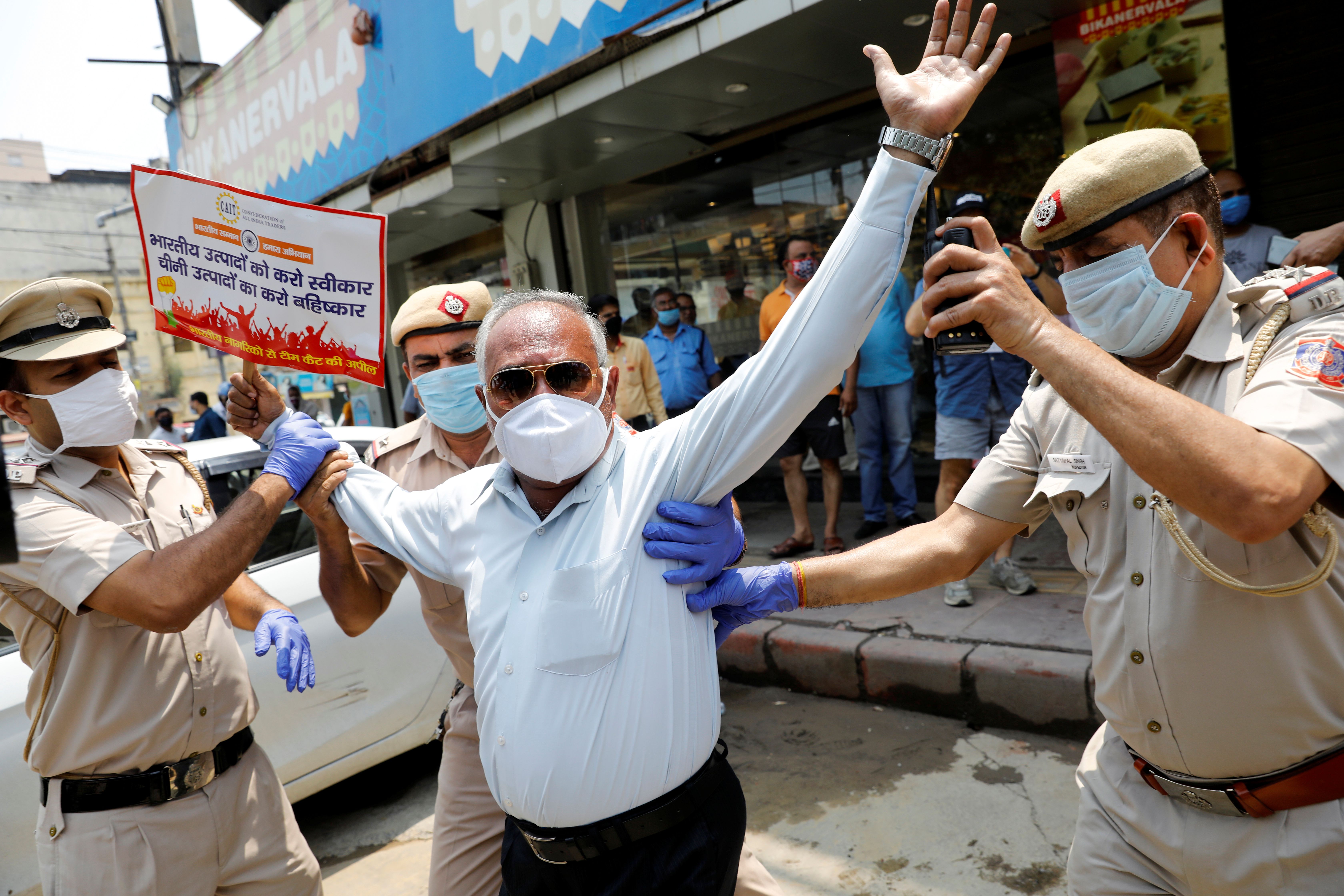From Cooperation to Confrontation: India’s Policy towards China

The brutal brawl between Indian and Chinese forces on the common border in Ladakh on 15 June in which at least 20 Indian soldiers and an unknown number of Chinese were killed has led to the most serious crisis in bilateral relations in nearly half a century. Although border tensions have spiked regularly in recent years (in the Depsang region in 2013, Demchok in 2014, Doklam in 2017), this time the number of Indian victims and China’s new territorial claims to the entire Galwan Valley make it difficult to return to the pre-crisis situation. While the EU called on “both sides to show restraint and to engage in military de-escalation”, the U.S. put the blame on China for increasing the tensions. Russia engaged to mitigate the crisis, which led to talks between the foreign ministers of India and China as part of an online tripartite summit on 23 June, which helped alleviate the situation.
China in Indian Foreign Policy
China is India’s largest neighbour, its main trading partner, and the most serious security challenge. The attitude towards China is heavily influenced by the memory of India’s humiliating defeat in the 1962 border war—only the historic visit of Indian Prime Minister Rajiv Gandhi to Beijing in 1988 initiated the normalisation of relations, which accelerated after the end of the Cold War. Since then, India had been developing cooperation with China, hoping deeper engagement would help resolve historical disputes. In 1993, both countries signed the Agreement on the Maintenance of Peace and Tranquillity along the Line of Actual Control (LAC) on the India-China Border Areas, and in 1996 another agreement, Confidence-Building Measures in the Military Field Along the LAC. In 2005, a Strategic and Cooperative Partnership for Peace and Prosperity was established. Top-level meetings have become more frequent and cooperation has developed around 30 sectoral dialogues. Trade increased from just over $3 billion in 2000 to $95 billion in 2018.
In sharing the experience of colonial exploitation and growing power ambitions, both countries criticized the post-Cold War unipolar international order and Western intervention in other countries. Their views converged on international issues such as climate-change negotiations or international trade. They collaborated on reform of global governance institutions, co-creating, among others, a tripartite dialogue with Russia (since 2003) and the BRICS group (Brazil-Russia-India-China-South Africa, since 2009). As part of BRICS, they established the New Development Bank in 2014, whose headquarters are in Shanghai but the first director is Indian. In 2015, India joined the Chinese initiative of the Asian Infrastructure Investment Bank (AIIB), where it became the second-largest shareholder and soon the largest beneficiary of support. In 2017, it also joined the Shanghai Cooperation Organisation, another Chinese initiative in the security area. Despite their cooperation, mutual relations have become increasingly tense, and the list of problems has been growing, especially since more nationalist leaders took power in both countries: Xi Jinping in China in 2012 and Narendra Modi in India in 2014.
Widening Differences
The most serious problem has been the non-delimited status of the long border (almost 3,500 km) in the Himalaya. Despite subsequent agreements on the border dispute (in 2003, 2005, and 2012) and formal negotiations ongoing since 2003 (21 rounds of talks), no progress has been made in this respect. The situation is dangerous because of serious mutual territorial claims, including China to the whole Indian state of Arunachal Pradesh and India to the China-controlled Aksai Chin region in Ladakh. The claims renewed in 2019 by Indian politicians of sovereignty over Aksai Chin and a new official map published in November 2019 showing this region as part of India could have been among the reasons for the recent build-up of Chinese troops along the LAC.
Another major concern for India is the growing China-Pakistan alliance. The latter not only benefits from Chinese diplomatic support and arms sales but also is the largest beneficiary under the Chinese Belt and Road Initiative (BRI). Since part of the “Economic Corridor” from the port of Gwadar, Pakistan, to Xinjiang, China, runs through the disputed territory of Kashmir, that was the main reason why India did not join the BRI and instead became one of its strong critics. Serious fears in India are caused also by China’s increased engagements in other South Asian countries and the Indian Ocean, which erodes the traditional Indian influence. In response, India is increasing its presence in China’s neighbourhood, for example, through cooperation with Vietnam and Japan, and in 2017 it joined the quadrilateral dialogue on security (called the Quad, it includes the U.S., Japan, Australia, and India), which was not perceived well by China.
India’s growing negative trade balance with China is another growing problem. In 2018, it totalled $58 billion, or almost half of its entire deficit. India criticizes barriers to access to the Chinese market and its fears of a flood of Chinese products was the reason it withdrew in 2019 from negotiations of the Regional Comprehensive Economic Partnership (RCEP)—a free-trade area of 15 Asian nations. One can add to this list of Indian grievances the Chinese veto on India’s accession to the Nuclear Suppliers Group (NSG) or lack of support for India’s bid to join the UN Security Council as a permanent member. For years, China in the UN has also blocked the listing of Masood Azhar, the Pakistani leader of the anti-Indian organisation JAishe-e-Mohammad, as a global terrorist. However, China withdrew its opposition before the parliamentary elections in India in May 2019, contributing to the victory of Prime Minister Modi, and showed readiness to make concessions in crucial moments.
India’s Dilemmas
The recent crisis has made proposals for a radical shift in policy towards China dominant in India, from cooperation to one that treats the former as a hostile power. The consequences would be the need for closer cooperation with the U.S. and other Quad members in the field of security and with other countries sharing concerns about China’s actions. Some Indian media have called for boycotting Chinese products, increasing tariffs, blocking Chinese investments and technology. These sentiments were reinforced by hopes for the relocation of some factories from China to India, because the COVID-19 pandemic has exposed many countries’ economic dependence on China.
Demands to tighten policy towards China will be difficult to implement, however, given the economic, military, and technological disparities between the neighbours. China’s military advantage (a defence budget three times greater) means that Indian military retaliation against China is not a viable option. The Chinese economy is also almost five times larger than India’s, so a possible trade war would probably affect India more severely. China also has a number of other opportunities to adversely affect India’s security situation, such as increasing support for Pakistan or triggering another border crisis.
Conclusions and Perspectives
Strong internal pressure for a firm response to China, on the one hand, and the power disparity between India and China, on the other, put Prime Minister Modi in a difficult situation. The likely response will be limited economic restrictions, including the exclusion of China from participation in strategic investments, such as the development of the 5G network. Regardless of whether the border incident was planned by China or not, it has caused irreparable damage to its image in India and limited the scope for bilateral partnership. Although the situation in the LAC is stabilising, one should expect a permanent tightening of India’s course towards China, including more open criticism of it internationally or limiting political dialogue. Relations could be improved, for example, by another Modi-Xi summit like the one after the Doklam crisis in 2017, but that would require concessions from China on borders, trade, support for the NSG nomination, or in some other areas important for India.
The countries’ geographical proximity, economic interdependence, and convergence of views on many global issues mean that it is in India’s interest not to pick sides in the U.S.-China rivalry. While guarding its strategic autonomy, India does not want either Chinese or American dominance in Asia. However, the increase in the perceived threat from China may leave India no option but to strengthen cooperation with the U.S., re-energize cooperation within the Quad, and become more open to closer partnership with the EU. Such a scenario would also paralyse cooperation within BRICS and strengthen tensions in Asia.


